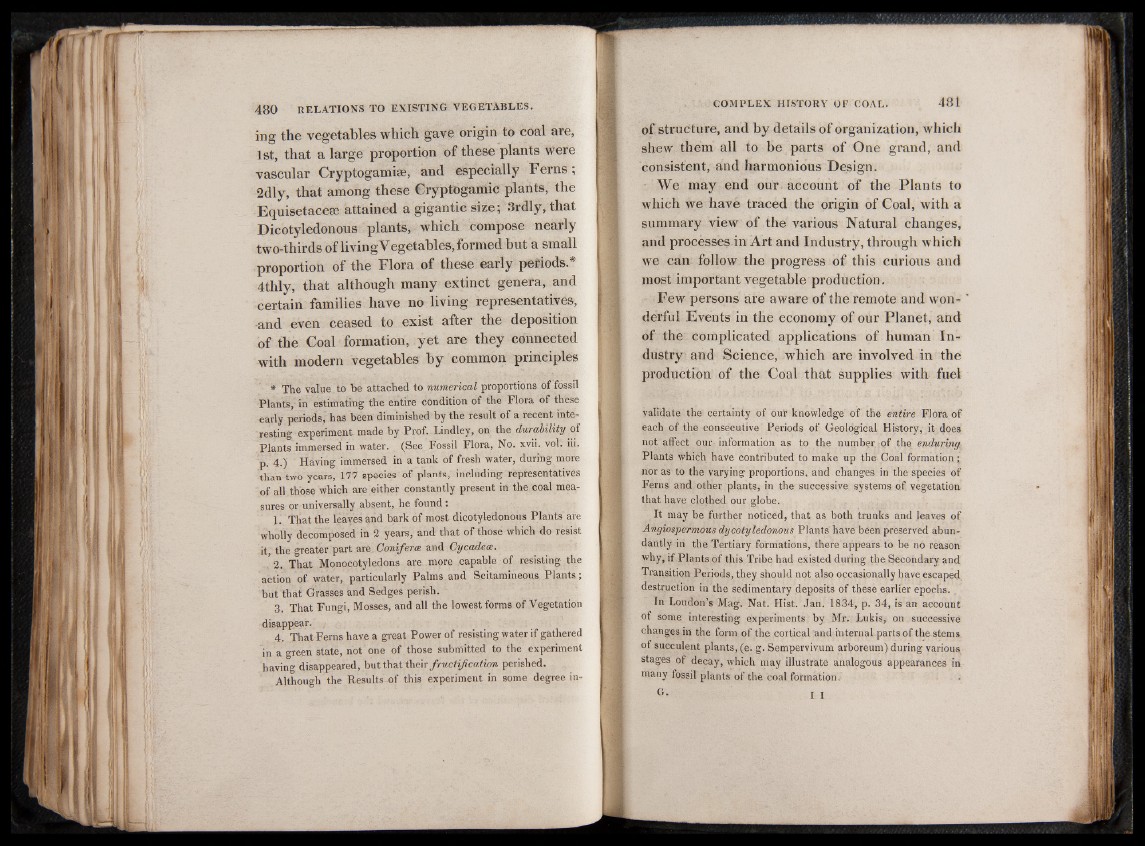
ing the vegetables which gave origin to coal are,
1st, that a large proportion of these plants were
vascular Cryptogamise, and especially Ferns;
2dly, that among these Cryptogamic plants, the
Equisetacese attained a gigantic size; 3rdly, that
Dicotyledonous plants, which compose nearly
two-thirds of living Vegetables, formed but a small
proportion of the Flora of these early periods.*
4thly, that although many extinct genera, and
certain families have no living representatives,
and even ceased to exist after the deposition
of the Coal formation, yet are they connected
with modern vegetables by common principles
* The value to be attached to numerical proportions of fossil
Plants, in estimating the entire condition of the Flora of these
early periods, has been diminished by the result of a recent interesting
experiment made by Prof. Lindley, on the durability of
Plants immersed in water. (See Fossil Flora, No. xvii. vol. iii.
p. 4.) Having immersed in a tank of fresh water, during more
than two years, 177 species of plants, including representatives
of all those which are either constantly present in the coal measures
or universally absent, he found:
1. That the leaves and bark of most dicotyledonous Plants are
wholly decomposed in 2 years, and that of those which do resist
it, the greater part are Conifera and Cycadea.
2. That Monocotyledons are more capable of resisting the
action of water, particularly Palms and Scitamineous Plants;
but that Grasses and Sedges perish.
3. That Fungi, Mosses, and all the lowest forms of Vegetation
disappear.
4. That Ferns have a great Power of resisting water if gathered
in a green state, not one of those submitted to the experiment
having disappeared, but that their fructification perished.
Although the Results of this experiment in some degree ino
f structure, and by details o f organization, which
shew them all to be parts o f One grand, and
consistent, and harmonious Design.
We may end our account o f the Plants to
which we havé traced the origin o f Coal, with a
summary view o f the various Natural changes,
and processes.in Art and Industry, through which
we can follow the progress o f this curious and
most important vegetable production.
Few persons are aware o f the remote and won- '
derful Events in the economy o f our Planet, and
o f the complicated applications o f human In dustry
and Science, which are involved in the
production o f the Coal that supplies with fuel
validate the certainty of óur knowledge of the entire Flora of
each of the consecutive Periods of Geological History, it does
not affect our information as to the number of the enduring
Plants which have contributed to make up the Coal formation;
nor as to the varying proportions, and changes in the species of
Ferns and other plants, in the successive systems of vegetation
that have clothed our globe.
It may be further noticed, that as both trunks and leaves of
Angiospermóus dycotyledonous Plants'have been preserved abundantly
in the Tertiary formations, there appears to be no reason
why, if Plants of this Tribe had existed during the Secondary and
Transition Periods, they should not also occasionally have escaped
destruction in the sedimentary deposits of these earlier epochs.
In Loudon’s Mag. Nat. Hist. Jan. 1834, p. 34, is an account
of some interesting experiments by Mr. Lukis, on successive
changes in the form of the cortical and internal parts of the stems
of succulent plants, (e. g. Sempervivum arboreum) during various,
stages of decay, which may illustrate analogous appearances in
many fossil plants of thè coal formation.
g . n